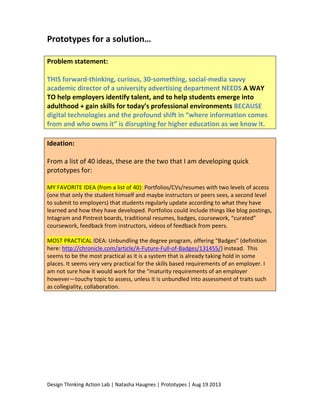
Prototype with feedback
- 1. Design Thinking Action Lab | Natasha Haugnes | Prototypes | Aug 19 2013 Prototypes for a solution… Problem statement: THIS forward-thinking, curious, 30-something, social-media savvy academic director of a university advertising department NEEDS A WAY TO help employers identify talent, and to help students emerge into adulthood + gain skills for today’s professional environments BECAUSE digital technologies and the profound shift in “where information comes from and who owns it” is disrupting for higher education as we know it. Ideation: From a list of 40 ideas, these are the two that I am developing quick prototypes for: MY FAVORITE IDEA (from a list of 40): Portfolios/CVs/resumes with two levels of access (one that only the student himself and maybe instructors or peers sees, a second level to submit to employers) that students regularly update according to what they have learned and how they have developed. Portfolios could include things like blog postings, Intagram and Pintrest boards, traditional resumes, badges, coursework, “curated” coursework, feedback from instructors, videos of feedback from peers. MOST PRACTICAL IDEA: Unbundling the degree program, offering “Badges” (definition here: http://chronicle.com/article/A-Future-Full-of-Badges/131455/) instead. This seems to be the most practical as it is a system that is already taking hold in some places. It seems very very practical for the skills based requirements of an employer. I am not sure how it would work for the “maturity requirements of an employer however—touchy topic to assess, unless it is unbundled into assessment of traits such as collegiality, collaboration.
- 2. Design Thinking Action Lab | Natasha Haugnes | Prototypes | Aug 19 2013 Prototype #1:The portfolio/ resume plus website with two views This is essentially a portfolio that students begin building from their first semester in school. With the two views (one for the student/advisor, and one for industry professionals), students develop an early metatcognitive awareness of themselves as learners, but they also get used to presenting themselves to employers and getting feedback from the “real world” well before graduation day. And hopefully, they see the relationship between these two “selves.” (Does this address the “emerging into adulthood” aspect of the problem?) Feedback from industry professionals will help guide students’ work, but it can also help the director hone his program (adding skills to the curriculum that are consistently lacking in the portfolios, for example). Benefits to employers are less clear to me at this point. Why would they want to participate? I suppose employers can use this tool to identify great candidates early on. (That is one of the reasons ATT is bankrolling the new computer science degree-through-MOOCs at Georgia Tech, according to yesterday’s NYT front page article.) This prototype needs to be made very visually pleasing—what is below is very very simple …
- 3. Design Thinking Action Lab | Natasha Haugnes | Prototypes | Aug 19 2013 [website mockup] Name Title Personal statement and goals Portfolio of best work What are you proud of? Short annotations and explanations can be included. Influences Annotated list of people/organizations you follow (on social media, authors, magazines &journals etc.) Work history Academic history Degrees, or courses you have completed. References People you have enjoyed working with who can serve as references Skills Pre-determined list of hard skills that can be selected (e.g. basic profciiency in photoshop,). These could also be “badges” Academic Reflection Journal Prompts from your academic advisor, responses from student. Reflections on process of education, reflections on employer feedback. (not viewable to employers) Employer feedback and comments (not viewable to employers)
- 4. Design Thinking Action Lab | Natasha Haugnes | Prototypes | Aug 19 2013 Prototype #2:Badges Samplingof badges (with definitions) that could offered. Students would be issued these badges as they are now issued official transcripts. The description of each badge needs to be very concise: “Breadth” Badges Basic writing (ability to write focused, clear prose that is understandable to an intended general reader) Basic Information literacy (ability to research answers to a question and assess the credibility of various sources, digital and analog.) “Technical” Badges Basic Photography and PhotographManipulation (use current photographic software to perform basic manipulations such as exposure and color correction; optimize resolution/size for a variety of uses of photographs) Design Basics (use design skills to create and manipulate images to create visual hierarchy) Typography(…) “Disciplinary thinking” badges Basic Creative Strategy in Advertising(…) Basic Art Direction in Advertising (…) Intermediate Art Direction in Advertising (…)
- 5. Design Thinking Action Lab | Natasha Haugnes | Prototypes | Aug 19 2013 I like the ideas. I would see them existing in an ecosystem together. This problem is too complex and will never be solved by a single tool (or even toolbox.) On the "Favorite Idea" would instructors/peers be a gateway to the "employer potfolio" - stuff couldn't get into it without approval from a trusted source (tied to LinkedIn or someway of trust)? Or would there be a badge system of approval? Reddit vote up? Does anything differentiate the two beyond what the student wants to allow? How do we not waste an employer's time? (as you mention, I don't know why an employer participates.) Also, choosing what moves from student -> professional portfolio, can that be a part of emerging adulthood? Hmmmm. I see no holes as of yet. Good prototype thinking. Response from stakeholders
